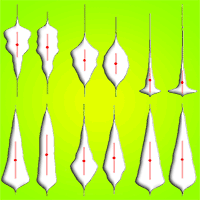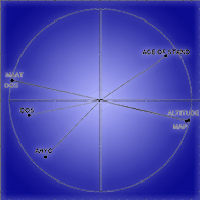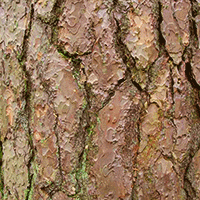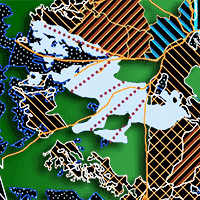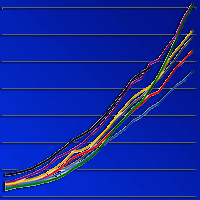Norway spruce (Picea abies [L.] Karst.) has been at the centre of controversy for many decades. Recent evidence of its profound disturbance-induced damage and consequent stock depletions across forest landscapes in Europe has reinforced doubts regarding the sustainability and prospects of this tree species in the future. Like many other European countries, Slovenia has experienced significant Norway spruce mortality and a decrease in growing stock primarily as the result of several disturbance agents (bark beetle outbreaks, an ice storm, windthrows). We investigated a countrywide spruce growing stock decline based on data between 2010 and 2018. Particular focus was placed on identifying the main ecological drivers of this decline, namely geological conditions, climatic parameters, soil attributes, topographic factors and forest stand characteristics. The effects of potential predictors on the relative change (%) in spruce volume (m3 ha-1) during the period 2010-2018 were analysed with Generalized Additive Models. Based on a national dataset including forest compartments (n = 6355) with a spruce growing stock decline > 10%, we found mixed support for ecology-based hypotheses. While spruce decline responded to bedrock type as predicted (i.e., greater relative decline in carbonate compared to silicate compartments), higher forest naturalness (preservation of tree species composition) was not associated with a lower decline. Spruce decline was amplified by higher potential evapotranspiration and soil clay content but showed a strong negative relationship with spruce proportion in the year 2010. General trends along the gradients of other selected predictors (stoniness/rockiness and heat load index) were less pronounced. The results suggest that most of these ecological predictors interact with geology and forest naturalness in affecting Norway spruce decline. Our analysis reveals that bedrock type can play an important role due to its mitigating effects. However, forest naturalness is of secondary significance as intensified large-scale forest disturbances likely override its buffering potential.
Keywords
, , , , ,
Citation
Kermavnar J, Kutnar L, Pintar AM (2023). Ecological factors affecting the recent Picea abies decline in Slovenia: the importance of bedrock type and forest naturalness. iForest 16: 105-115. - doi: 10.3832/ifor4168-016
Academic Editor
Alessandro Vitali
Paper history
Received: Jun 24, 2022
Accepted: Jan 19, 2023
First online: Mar 29, 2023
Publication Date: Apr 30, 2023
Publication Time: 2.30 months
© SISEF - The Italian Society of Silviculture and Forest Ecology 2023
Open Access
This article is distributed under the terms of the Creative Commons Attribution-Non Commercial 4.0 International (https://creativecommons.org/licenses/by-nc/4.0/), which permits unrestricted use, distribution, and reproduction in any medium, provided you give appropriate credit to the original author(s) and the source, provide a link to the Creative Commons license, and indicate if changes were made.

Breakdown by View Type
(Waiting for server response...)
Article Usage
Total Article Views: 24820
(from publication date up to now)
Breakdown by View Type
HTML Page Views: 19115
Abstract Page Views: 3732
PDF Downloads: 1596
Citation/Reference Downloads: 7
XML Downloads: 370
Web Metrics
Days since publication: 1008
Overall contacts: 24820
Avg. contacts per week: 172.36
Article Citations
Article citations are based on data periodically collected from the Clarivate Web of Science web site
(last update: Mar 2025)
Total number of cites (since 2023): 6
Average cites per year: 2.00
Publication Metrics
by Dimensions ©
Articles citing this article
List of the papers citing this article based on CrossRef Cited-by.
(1)
Albrich K, Rammer W, Seidl R (2020)Climate change causes critical transitions and irreversible alterations of mountain forests. Global Change Biology 26: 4013-4027.
CrossRef |
Gscholar
(2)
Andrus RA, Chai RK, Harvey BJ, Rodman KC, Veblen TT (2021)Increasing rates of subalpine tree mortality linked to warmer and drier summers. Journal of Ecology 109: 2203-2218.
CrossRef |
Gscholar
(3)
Balazy R, Zasada M, Ciesielski M, Waraksa P, Zawila-Niedzwiecki T (2019)Forest dieback processes in the Central European Mountains in the context of terrain topography and selected stand attributes. Forest Ecology and Management 435: 106-119.
CrossRef |
Gscholar
(4)
Bončina A, Robič D (1998)Ocenjevanje spremenjenosti vrstne sestave rastlinskih skupnosti [Estimating the alterations of species composition of plant communities]. Zbornik Gozdarstva in Lesarstva 57: 113-130. [in Slovenian]
Gscholar
(5)
Bončina A, Klopčič M, Simončič T, Dakskobler I, Ficko A, Rozman A (2017)A general framework to describe the alteration of natural tree species composition as an indicator of forest naturalness. Ecological Indicators 77: 194-204.
CrossRef |
Gscholar
(6)
Caudullo G, Tinner W, De Rigo D (2016)Picea abies in Europe: distribution, habitat, usage and threats. In: “European Atlas of Forest Tree Species” (San-Miguel-Ayanz J, de Rigo D, Caudullo G, Houston Durrant T, Mauri A. eds). Publication Office of the European Union, Luxembourg, pp. 114-116.
Online |
Gscholar
(7)
De Groot M, Ogris N, Kobler A (2018)The effects of a large-scale ice storm event on the drivers of bark beetle outbreaks and associated management practices. Forest Ecology and Management 408: 195-201.
CrossRef |
Gscholar
(8)
De Groot M, Ogris N (2019)Short-term forecasting of bark beetle outbreaks on two economically important conifer tree species. Forest Ecology and Management 450: 117495.
CrossRef |
Gscholar
(9)
De Groot M, Diaci J, Ogris N (2019)Forest management history is an important factor in bark beetle outbreaks: Lessons for the future. Forest Ecology and Management 433: 467-474.
CrossRef |
Gscholar
(10)
Diaci J, De Groot M, Ogris N (2021)Ohranjenost drevesne sestave in realizacija možnega poseka zmanjšujeta obseg sanitarnih sečenj v Sloveniji [Preserved tree species mixture and realization of the possible harvest reduce the amount of sanitary fellings in Slovenia]. Gozdarski Vestnik 79: 28-32. [in Slovenian]
Gscholar
(11)
EUFORGEN (2013)Distribution map of Norway spruce (
Picea abies). European Forest Genetic Resources Programme (EUFORGEN), European Forest Institute, Barcelona, Spain.
Online |
Gscholar
(12)
Fick SE, Hijmans RJ (2017)WorldClim 2: new 1-km spatial resolution climate surfaces for global land areas. International Journal of Climatology 37: 4302-4315.
CrossRef |
Gscholar
(13)
Griess VC, Acevedo R, Härtl F, Staupendahl K, Knoke T (2012)Does mixing tree species enhance stand resistance against natural hazards? A case study for spruce. Forest Ecology and Management 267: 284-296.
CrossRef |
Gscholar
(14)
Hastie T, Tibshirani R (1990)Generalized additive models. Chapman and Hall, CRC Press, London, UK, pp. 352.
Gscholar
(15)
Hengl T, Mendes De Jesus J, Heuvelink GBM, Ruiperez Gonzalez M, Kilibarda M, Blagotić A, Shangguan W, Wright MN, Geng X, Bauer-Marschallinger B, Guevara MA, Vargas R, MacMillan RA, Batjes NH, Leenaars JGB, Ribeiro E, Wheeler I, Mantel S, Kempen B (2017)SoilGrids250m: global gridded soil information based on machine learning. PloS One 12: e0169748.
CrossRef |
Gscholar
(16)
Hijmans RJ (2020)Package “Raster”- Geographic data analysis and modelling. version 3:4-5, web site.
Online |
Gscholar
(17)
Hlásny T, Turčáni M (2013)Persisting bark beetle outbreak indicates the unsustainability of secondary Norway spruce forests: Case study from Central Europe. Annals of Forest Science 70: 481-491.
CrossRef |
Gscholar
(18)
Hlásny T, Zimová S, Merganičová K, Stepánek P, Modlinger R, Turčáni M (2021)Devastating outbreak of bark beetles in the Czech Republic: drivers, impacts, and management implications. Forest Ecology and Management 490: 119075.
CrossRef |
Gscholar
(19)
Kutnar L, Kermavnar J, Pintar AM (2021)Climate change and disturbances will shape future temperate forests in the transition zone between Central and SE Europe. Annals of Forest Research 64: 67-86.
CrossRef |
Gscholar
(20)
Levanič T, Gričar J, Gagen M, Jalkanen R, Loader NJ, McCarroll D, Oven P, Robertson I (2009)The climate sensitivity of Norway spruce [
Picea abies (L.) Karst. ] in the southeastern European Alps. Trees 23: 169-180.
CrossRef |
Gscholar
(21)
Marini L, Okland B, Jönsson AM, Bentz B, Carroll A, Forster B, Grégoire J-C, Hurling R, Nageleisen LM, Netherer S, Ravn HP, Weed A, Schroeder M (2017)Climate drivers of bark beetle outbreak dynamics in Norway spruce forests. Ecography 40: 1426-1435.
CrossRef |
Gscholar
(22)
McCune B, Keon D (2002)Equations for potential annual direct incident radiation and heat load. Journal of Vegetation Science 13: 603-606.
CrossRef |
Gscholar
(23)
Mezei P, Jakuš R, Pennerstorfer J, Havašová M, Skvarenina J, Ferenčík J, Slivnisky J, Bičárová Bilčík D, Blaenec M, Netherer S (2017)Storms, temperature maxima and the Eurasian spruce bark beetle
Ips typographus - An infernal trio in Norway spruce forests of the Central European High Tatra Mountains. Agricultural and Forest Meteorology 242: 85-95.
CrossRef |
Gscholar
(24)
Munteanu C, Kuemmerle T, Keuler NS, Müller D, Balázs P, Dobosz M, Griffiths P, Halada L, Kaim D, Konkoly-Gyuró E, Kozak J, Lieskovsky J, Ostafin K, Ostapowicz K, Shandra O, Radeloff VC (2015)Legacies of 19
th century land use shape contemporary forest cover. Global Environmental Change 34: 83-94.
CrossRef |
Gscholar
(25)
Nagel TA, Firm D, Rozenbergar D, Kobal M (2016)Patterns and drivers of ice storm damage in temperate forests of Central Europe. European Journal of Forest Research 135: 519-530.
CrossRef |
Gscholar
(26)
Netherer S, Panassiti B, Pennerstorfer J, Matthews B (2019)Acute drought is an important driver of bark beetle infestation in Austrian Norway spruce stands. Frontiers in Forests and Global Change 2: 39.
CrossRef |
Gscholar
(27)
Ogris N, Grecs Z (2016)Prenamnožitev osmerozobega in šesterozobega smrekovega lubadarja v Sloveniji v 2016 [Reproduction of eight-toothed and six-toothed spruce bark beetles in Slovenia in year 2016]. Napovedi o zdravju gozdov, Ljubljana, Slovenia. [in Slovenian]
CrossRef |
Gscholar
(28)
R Core Team (2020)R: a language and environment for statistical computing. R Foundation for Statistical Computing, Vienna, Austria.
Online |
Gscholar
(29)
Schütz J-P, Saniga M, Diaci J, Vrska T (2016)Comparing close-to-nature silviculture with processes in pristine forests: lessons from Central Europe. Annals of Forest Science 73: 911-921.
CrossRef |
Gscholar
(30)
Seidl R, Müller J, Hothorn T, Bässler C, Heurich M, Kautz M (2016)Small beetle, large-scale drivers: how regional and landscape factors affect outbreaks of the European spruce bark beetle. Journal of Applied Ecology 53: 530-540.
CrossRef |
Gscholar
(31)
Simard M, Powell EN, Raffa KF, Turner MG (2012)What explains landscape patterns of tree mortality caused by bark beetle outbreaks in Greater Yellowstone? Global Ecology and Biogeography 21: 556-567.
CrossRef |
Gscholar
(32)
Sommerfeld A, Senf C, Buma B, D’Amato AW, Després T, Díaz-Hormazábal I, Fraver S, Frelich LE, Gutiérrez AG, Hart SJ, Harvey BJ, Hong SH, Hlásny T, Holz A, Kitzberger T, Kulakowski D, Lindenmayer D, Mori AS, Müller J, Paritsis J, Perry GLW, Stephens SL, Svoboda M, Turner MG, Veblen TT, Seidl R (2018)Patterns and drivers of recent disturbances across the temperate forest biome. Nature Communications 9: 1-9.
CrossRef |
Gscholar
(33)
Sommerfeld A, Rammer W, Heurich M, Hilmers T, Müller J, Seidl R (2020)Do bark beetle outbreaks amplify or dampen future bark beetle disturbances in Central Europe? Journal of Ecology 109: 1-13.
CrossRef |
Gscholar
(34)
Spiecker H (2003)Silvicultural management in maintaining biodiversity and resistance of forests in Europe - temperate zone. Journal of Environmental Management 67: 55-65.
CrossRef |
Gscholar
(35)
Skrk N, Serrano-Notivoli R, Cufar K, Merela M, Crepinšek Z, Kajfe Bogataj L, De Luis M (2021)SLOCLIM: a high-resolution daily gridded precipitation and temperature dataset for Slovenia. Earth System Science Data 13: 3577-3592.
CrossRef |
Gscholar
(36)
Stadelmann G, Bugmann H, Wermelinger B, Bigler C (2014)Spatial interactions between storm damage and subsequent infestations by the European spruce bark beetle. Forest Ecology and Management 318: 167-174.
CrossRef |
Gscholar
(37)
Temperli C, Veblen TT, Hart SJ, Kulakowski D, Tepley AJ (2015)Interactions among spruce beetle disturbance, climate change and forest dynamics captured by a forest landscape model. Ecosphere 6: 1-20.
CrossRef |
Gscholar
(38)
Thom D, Seidl R, Steyrer G, Krehan H, Formayer H (2013)Slow and fast drivers of the natural disturbance regime in Central European forest ecosystems. Forest Ecology and Management 307: 293-302.
CrossRef |
Gscholar
(39)
Trabucco A, Zomer RJ (2009)Global Aridity Index (Global-Aridity) and Global Potential Evapo-Transpiration (Global-PET) Geospatial Database. CGIAR Consortium for Spatial Information, web site.
Online |
Gscholar
(40)
Trubin A, Mezei P, Zabihi K, Surovy P, Jakuš R (2022)Northernmost European spruce bark beetle
Ips typographus outbreak: modelling tree mortality using remote sensing and climate data. Forest Ecology and Management 505: 119829.
CrossRef |
Gscholar
(41)
Vitasse Y, Bottero A, Rebetez M, Conedera M, Augustin S, Brang P, Tinner W (2019)What is the potential of silver fir to thrive under warmer and drier climate? European Journal of Forest Research 138: 547-560.
CrossRef |
Gscholar
(42)
Wood SN (2017)Generalized additive models: an introduction with R (2nd edn). Chapman and Hall/CRC, New York, USA, pp. 496.
Online |
Gscholar
(43)
ZGS (2019)Poročila Zavoda za gozdove Slovenije o gozdovih za leta od 2010 do 2018 [Annual Reports of Slovenia Forest Service regarding forest status for years from 2010 to 2018]. Slovenia Forest Service, Ljubljana, Slovenia, pp. 133. [in Slovenian]
Gscholar
(44)
ZGS (2010a)Forest stands data. Zavod za gozdove Slovenije (Slovenia Forest Service), Institutional database, Ljubljana, Slovenia.
Gscholar
(45)
ZGS (2010b)Forest compartments data. Zavod za gozdove Slovenije (Slovenia Forest Service), Institutional database, Ljubljana, Slovenia.
Gscholar
(46)
ZGS (2018a)Forest stands data. Zavod za gozdove Slovenije (Slovenia Forest Service), Institutional database, Ljubljana, Slovenia.
Gscholar
(47)
ZGS (2018b)Forest compartments data. Zavod za gozdove Slovenije (Slovenia Forest Service), Institutional database, Ljubljana, Slovenia.
Gscholar
